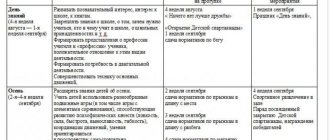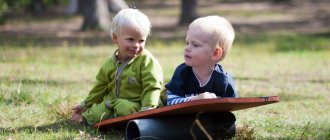An educational event as a form of interaction between all participants in the educational process in a preschool educational institution
EDUCATIONAL EVENT AS A FORM OF INTERACTION OF ALL PARTICIPANTS OF THE EDUCATIONAL PROCESS IN A preschool educational institution
Tyutyunnik G.G.
MBDOU No. 10
The federal state educational standard for preschool education involves changes in the content and forms of organization of the educational process. Currently, in the pedagogical environment there is interest in the concept of “educational event”, which is associated, first of all, with its effectiveness in the development of the child’s personality.
An educational event is a special form of organization and implementation of educational activities.
According to B.D. Elkonin, “an event is not a consequence and continuation of the natural course of life. The event is connected precisely with the interruption of this flow and the transition to another reality. That is, the event must be understood as a responsible action, as a transition from one type of behavior to another, from one idea to another, from misunderstanding of another to its mastery and acceptance. The event cannot be understood as an accident. The event involves very serious, difficult and intense work and experience.”
The essence of an educational event is that special conditions are organized for children’s action; the experience gained, meaningful and conscious, turns into a means to achieve a new, higher goal.
The value of an educational event is that it creates a holistic unity of the educational process, and its content reflects the picture of everything studied, acquired, accumulated, formed in the creative, speech, cultural, emotional sphere. The educational event also presents a holistic picture of the child’s personal qualities - performance, perseverance, diligence and the qualities of interpersonal communication - creative cooperation, kindness, responsiveness, empathy. Preparing for an educational event is a creative process and joint activity of the teacher, children, parents, where everyone finds a place for themselves and learns new possibilities of their personal qualities.
As researchers note, for preschoolers, an educational event is a form of joint activity between a teacher and children, which is planned and purposefully organized by the teacher in order to solve certain problems of development, education and training. A feature of an educational event is the emergence of an educational result (product) that arises during a specially organized interaction between a teacher and a child. Such products can be either material (a story, drawing, craft, collage, exhibition piece, mini-museum) or intangible (new knowledge, image, idea, attitude, experience, etc.).
In practice, we were faced with the question: how to organize an educational event so that all its participants were active - both children and adults: educators, preschool specialists and the students’ families.
Therefore, the object of our research was an educational event.
The subject is the interaction of all participants in the educational process during its preparation and organization.
The goal was to summarize pedagogical experience in conducting and preparing educational events for the development of children’s musical abilities.
The goal identified the following tasks:
- Analyze the available literature on the problem;
- Develop a technology for organizing an educational event;
- To analyze the experience of interaction of all participants in the educational process in the implementation of the tasks of musical development of children.
Analysis of theoretical studies, regulatory documents, and practical recommendations allowed us to determine the stages of work, formulate tasks and outline ways to solve identified problems.
To organize an educational event in a preschool educational institution, we have identified several stages:
Stage 1: determining the topics of educational events in accordance with the content of the educational program. Activities are recorded in a comprehensive thematic, annual work plan of the preschool educational institution, and in teachers’ calendar plans.
Stage 2: – setting goals and objectives for the upcoming educational event, planning the stages of preparation.
Stage 3: preparation for the educational event.
Stage 4: holding an educational event, the most wonderful and long-awaited moment of action.
Stage 5: analytical, reflection is carried out, the effect of participation in the educational event is revealed.
We organize the interaction of teachers - educators, specialists - and families of students on the implementation of eventfulness at every stage.
The teacher’s activities are carried out at various levels: when modeling the subject-spatial environment, conducting educational activities, in the process of regime moments, individual and group forms, interaction with family and society.
The peculiarity of this activity is that it is flexible, differentiated in nature and includes elements of spontaneity and improvisation, requires a number of professional skills, including the ability to observe the activities, behavior and relationships of children, analyze current events, and interpret the results obtained.
In accordance with the stages of activity, we determine the role and responsibilities of each participant in the educational event.
So, at stages 1 and 2, we jointly determine the topic, plan the goals and objectives of the upcoming event. Ideally, joint activities between teachers and students should be organized here, but in practice this does not always work out that way. Therefore, the teacher himself determines the goals and objectives of the educational event. As a rule, several teachers participate in this event, and they organize this activity jointly. For each specialist, it will be associated with their direct educational activities: for a physical education instructor with motor activity, for speech therapists with speech correction, for a music director with the development of musical abilities. The goals of organized educational activities of different content and form, traditional and non-traditional, are being determined. Teachers determine what additional resources they need to carry out the educational event (their joint activities are planned, including with parents, a model for achieving the goal is developed, the means necessary to achieve it are determined, the activities at each step are detailed, taking into account the individual characteristics of the individual, relationships in the group and readiness for the event). Through various forms of interaction with the families of pupils, we increase the competence of parents on certain issues, inform them about upcoming events. We widely use information stands, reminders, booklets, interaction notebooks, etc.
At the third stage, in the process of preparing for the educational event, educators and specialists - speech therapists, music director, physical education instructor - organize joint activities with children, as a result, pupils receive ideas, knowledge and skills that will be necessary when conducting educational events. Here, direct educational activities are organized in classes and during routine moments. In the process of preparing for an educational event, students gain knowledge and skills that will be necessary in the future. Teachers and specialists organize various types of activities, children are given game tasks, parents actively help to carry out creative work, and thematic materials are viewed together. But it is important not only for children to learn the content of the main educational program, but also to be able to use it in various – similar and non-standard – situations. Therefore, the effectiveness of the implementation of the assigned tasks largely depends on the content of the subject-game environment. Both teachers and parents also take part in its enrichment. At the same time, the object-based play environment is designed to help solve the problems of purposefully enriching children’s ideas, comprehensive development and personality formation of preschoolers. At this stage, parents are actively involved in the educational process and, together with their children, participate in projects, exhibitions, master classes, and creative workshops.
The fourth stage is the brightest and most long-awaited. This is the direct conduct of an educational event. The scenario of the educational event itself is developed by teachers - educators and specialists. Vivid visibility (design of an exhibition of children's works, design of the event venue according to the theme, creative play action, surprise and surprise are mandatory criteria for preparing an educational event).
The developed technology helps solve the problems of the main educational program of preschool education, including the development of children's musical abilities. And this is especially valuable for the music director, since he is actively involved in all stages of organizing an educational event.
Our events included various forms of work: a holiday, thematic entertainment, impromptu entertainment, improvisation entertainment, game entertainment, a musical lounge, project activities, KVN, a creative workshop (we make musical instruments, we make gifts for the hero), an excursion, a game library , concert, concert-conversation, musical and didactic games, introduction to the theater, dramatization of fairy tales, experimentation, noisy celebration in a group, sweet evening, fun games, role-playing games, evenings of tricks and jokes.
Solving the problems of music education, the children and I celebrated the birthday of our kindergarten. We met with “Kapitoshka”, played with droplets of water, experimented with them. We were introduced to factory-made musical instruments. Together with my parents, I made homemade noise instruments for the exhibition and organized an orchestra for the hero.
At the same time, they used such forms of work as watching a cartoon; listening to songs about Kapitoshka; fun game “Drops are dripping everywhere”; finger game "Drops"; experimenting with sounds; orchestra; musical dramatization game “Drip-drip, drops are ringing.”
The educational event of this topic was the entertainment “It’s Kapitoshka’s birthday.”
During the week of music, such forms of work were used as meetings with interesting people: “Musicians in my family”; listening to music “Sounds of Spring”; demonstration of the educational film “Nature Comes to Life”; musical minutes “The violin sings tenderly”; educational story about the composer; joint music playing with schoolchildren - guests from the art school; dubbing the fairy tale “Journey through a Musical Country.” An educational event was the competition “Dad, Mom, Me - a Musical Family.”
At the same time, any of the participants in an educational event is really a participant, and not a spectator: everyone has their own meanings, their own activities, their own experiences, but the field of choice is such that the child should have unlimited possibilities in choosing limited (content and time) resources.
The last stage is analytical. Following the results of the educational event, we exchange opinions on participation in the event, all participants share their impressions and express their opinions about the experience. At the assessment stage, the results obtained are analyzed, the effectiveness of the educational impact is determined, the positive and negative experiences of organizing and implementing the event are taken into account, and taking into account the analysis, adjustments are made to the educational process. The effectiveness of activities on music education in this direction is confirmed by the results: the mastery by all children of the basic educational program of preschool education, indicators of the development of musical abilities, an increase in the number of children continuing their education in art schools, vocal studios, and dance groups.
Thus, the developed technology makes it possible to organize an educational event in such a way that all its participants are active - both children and adults: educators, preschool specialists and the students’ families. And this will contribute to solving the problems of the main educational program of preschool education.
BIBLIOGRAPHY:
- Vetlugina N.A., Keneman A.V. Theory and methods of music education in kindergarten. - M, 1983.
- Koreneva Tatyana Fedorovna Musical and rhythmic movements for children of preschool and primary school age. In 2 parts. Part 2.-M.: VLADOS, 2001.-
- Federal Law of December 29, 2012 No. 273-FZ “On Education in the Russian Federation.”
- Federal state educational standard for preschool education. Approved by order of the Ministry of Education and Science of the Russian Federation dated October 17, 2013.
Educational event lesson plan (preparatory group)
"Autumn has come to visit us"
Goal: To summarize and systematize children’s knowledge about autumn phenomena in nature.
Tasks:1. Summarize and systematize children’s knowledge about autumn phenomena in nature (short days and long nights, drizzling lingering rains, falling leaves, slush, decreased air temperature).2. Clarify and expand vocabulary on the topic, improve the grammatical structure of speech by coordinating words of nouns with numerals , continue to learn how to form relative adjectives.3. Develop intonation and facial expression of speech, general motor skills of the hands.4. Develop skills of cooperation, kindness and love of nature.
Preliminary work: Conversations about autumn, highlighting signs in different periods, observing changes in nature, reading poetry, guessing riddles about autumn, looking at illustrations on the topic “Autumn”, talking about migratory birds; various didactic games, various types of cutting out of colored paper.
Progress of the lesson:
Children enter a group, and multi-colored leaves are scattered on the floor.
Educator: Children, what happened here?
Children: Autumn has come.
Teacher (reads a poem)
Autumn begins, the leaves are falling off. Their cheerful round dance is the wind circling and carrying. Everything is covered with leaves, yellow, red, gold. Children collect these leaves and name from which trees they fell. D / game “Tell from which tree the leaves” The birch has leaves ... birch. The maple has leaves... maple. The oak has leaves... oak. The poplar has leaves... poplar. The aspen has leaves... aspen. The linden has leaves... linden. The rowan has leaves... rowan. The chestnut has leaves... chestnut.
Educator: Children, what is the name of the natural phenomenon when leaves fall?
Children: Leaf fall
Educator: We will rest a little and do some physical exercise.
We are autumn leaves, (Smooth swaying of hands above head.)
We are sitting on the branches.
The wind blew and they flew. (Hands to the side.)
We were flying, we were flying
And they sat down quietly on the ground. (Sit down.)
The wind came again
And he picked up all the leaves. (Smoothly swing your arms above your head.)
Spun and flew
And they sat down on the ground again. (Children sit down.)
Educator: Do you like to solve riddles? Listen to my riddle.
Came without paints
And without a brush,
And repainted all the leaves.
Educator: What time of year is this riddle about?
Children: Autumn.
Educator: Autumn is a wonderful time of year, it has three periods, which ones?
Children: Early, golden, late autumn.
Educator: Well done, what autumn months do you know?
Children: September, October, November.
Educator: September refers to early autumn, October to golden, and November to late autumn.
Children, what happens to nature in the fall, name the signs of autumn.
Children: Leaves begin to fall from the trees, birds fly south, it rains more often, the sun is not as warm anymore, the days are getting shorter, the harvest of vegetables and fruits is being harvested.
Educator: Correct. Birds begin to fly away in October. And you
Do you know what they call birds that fly to warmer regions?
Children: Migratory
Educator: Why do they fly away?
Children: With the onset of cold weather, insects disappear.
Educator: You have parts of the picture on your table, put them together into one whole picture and tell me what sign you got.
D/i “Collect a picture” (Children work in pairs, collecting a picture cut into pieces with signs of autumn)
(The teacher asks what pictures they got?)
Educator: Please look at the board, what is shown there?
(a tree is drawn on the poster)
Children: Tree. Educator: It seems to me that something is missing on the tree? Children: leaves Teacher: Children, you will cut out multi-colored leaves and stick them on the tree and near the tree. Let's get our fingers ready.
Finger game “Autumn Bouquet”
One, two, three, four, five, (bend your fingers, starting with the thumb)
We will collect leaves (clench and unclench our fists)
Birch leaves (bend your fingers, starting with the thumb)
Rowan leaves
poplar leaves,
Aspen leaves,
We will collect oak leaves,
We’ll take the autumn bouquet to mom (“walk” along the table with the middle and index fingers)
(Children do the appliqué on their own)
Educator: Well done guys, look what a beautiful picture we have. Let's give this picture to the kids.



